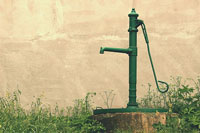Home Building Articles
Your Spring Water Well News
May 2016

Well Maintenance Is Important!
The safety and purity of your drinking water and the efficient operation of your private well system depends on a well-organized maintenance program. Protect your investment by regularly inspecting your well, testing your water, maintaining any water treatment devices, and your septic system!
Well Inspection
Like any large appliance in your home, you should also create a maintenance plan for your water well system. You should inspect your wellhead several times a year. Check the condition of the well covering., casing, and well cap to make sure all are in good repair, leaving no cracks or other entry points for potential pollutants. Have the well system, including the pump, storage tank, pipes and valves, and water flow inspected every 10 years by a qualified well contractor or pump installer. If you have no inspection record and cannot determine the age of the well, have it inspected immediately by a water well professional.
Water Testing
To keep your well water clean and pure and your well operating at peak performance, regular water testing is an important maintenance tool. Private well owners are solely responsible for the quality of their drinking water. So it is up to you, the well owner, to decide when and how to test your water.
At a minimum, your water should be tested every year for bacteria, the most common water quality problem. Other tests may be required, depending on where you live and what is located near your water well. Test more than once a year in special situations; someone in the house hold is pregnant or nursing; there are unexplained illnesses in the family; your neighbors find a dangerous contaminant in their water; or there is a spill or chemicals or fuels into or near your well.
Contact your local health department, cooperative extension service office, state environmental agency or the wellcare® hotline at 888-395-1033 for other water testing guidelines and to find a state certified water testing laboratory in your area.
Understanding Your Well Water Test Results
Many well owners are stumped when they receive their test results from the laboratory. The often confusing measurements, limits, and standards make it tough to determine if your water is safe or if it needs some type of treatment.
Most substances in water are measured as a concentration: a specific mass of a specific chemical within a specific unit or volume of water. The confusing part is that different terms can be used to reflect the exact same measurement:
- part per million/ppm = milligram per liter of water = mg/L
- part per billion/ppb = microgram per liter of water = ug/L
So what do these terms really mean? Basically, they refer to very small amounts of a substance within about a quart of water. (A liter amounts to 1/05 quarts.)
The U.S. Environmental Protection Agency (EPA) regulates public water supplies but not private well. Well owners can use EPA's, so check with your local or state health department for specific substances of concern.
Maximum Contaminant Levels (MCL's) are the highest level of a contaminant that the EPA allows in drinking water. MCL's are legally enforceable for public water supplies. When they turn up in the water, a utility must treat and remove or reduce the contaminant below the maximum level to protect public health.
EPA also sets standards for a second group of contaminants. These limits serve as guidelines for good water quality, but are not required by law. These National Secondary Drinking Water Regulations (NSDWRs), known as the secondary standards, regulate contaminants that may cause cosmetic effects, such as skin or tooth discoloration, or aesthetic effects, such as taste, odor or color, in drinking water. These standards are under discussion, but are not yet an official EPA recommendation or regulation.
The chart below is a road map to your test results. It lists each contaminant, how it is regulated or not, and the maximum levels in all the measurements you are likely to see. You can cross reference your test results with the chart to determine your water quality.
Water Treatment
First, it is important to note that most well water is a safe, reliable drinking water source for you and your family. Water treatment may not be necessary. Some contaminants may be more of a "cosmetic" issue (odor, discoloration, etc.) and may not present any health risks. Test your water before installing any water treatment device.
Septic Systems
Approximately 20 percent of U.S. households rely on onsite wastewater systems to dispose of wastewater on their property. Homeowners with both wells and septic systems must take care to maintain their systems in order to insure the purity of their drinking water.
Just like your well, you should inspect the septic tank each year for capacity and leaks. Have your tank pumped out as needed, usually every three to five years, based on the number of people in the household and the size of the tank. Repair the tank or drain field system as needed to prevent leaks of bacteria and nutrients into ground water.